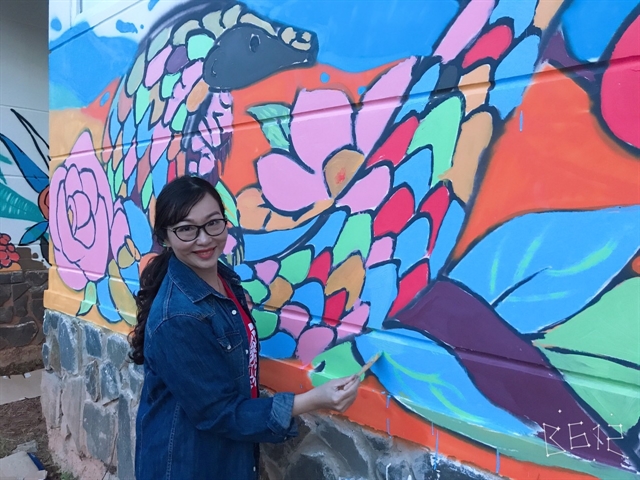 Environment
Environment

By Minh Hương
.png)
|
| Ivory bracelet is available in most e-commerce in Việt Nam. — Screenshot photo |
HÀ NỘI — Displaying an ivory bracelet on Zalo, a man called Tuấn Tây Nguyên tells me: “It is from a real tusk. It will bring lots of luck to your life. Believe me.”
Although the law prohibits any possession or sale of ivory items, jewellery made from these wild animals is widely available across the country, both in physical stores and online.
Tuấn asks me for VNĐ7 million for the bracelet, saying it will be sent safely from the central highlands to Hà Nội. When I ask whether it is legal to ship such an item, Tuấn tells me: “Don’t worry. I send them everywhere without any problems.”
At a seminar discussing the wildlife trade in Việt Nam at Bidoup Núi Bà National Park in Lâm Đồng Province in late September, Hoàng Thị Minh Hồng, director of CHANGE, said: “Việt Nam, together with China and Thailand, are the three countries with the highest consumption of illegal animals in the world.”
As leader of a local NGO with the focus to raise the wildlife awareness campaign in Việt Nam, Hồng adds: “They lead the world in the trade of rhino horn, ivory and pangolin products.”
Hồng told Việt Nam News: “Within ten years to 2019, 76 tonnes of ivory was imported into Việt Nam, equivalent to more than 11,500 animals.”
Tuấn’s profile picture on Zalo is a piece of ivory crafted into a statue of Guan Yin Buddha. He says he will sell it for VNĐ100 million. He tells me his customers want such items in their cars for good luck and to show off their affluence.
On Shopee, Lazada and Tiki, people can easily find pieces of ivory for sale. Bracelets, rings, necklaces, and statues made of ivory can be found, each costing from hundreds of thousands to millions of Vietnamese dong.
Channels on YouTube and Facebook host livestreams, guiding viewers on how to tell real products from fake ones.
Though there is no scientific or cultural basis to confirm that wearing ivory jewellery will bring good luck to the wearer, the unfounded rumours convince buyers: “As elephants are such big and strong creatures, their tusks will bring luck,” a seller named Hồng Anh said in a video on YouTube.
In 1994, Việt Nam joined CITES, or the Convention on International Trade in Endangered Species of Wild Fauna and Flora. The group aims to tighten the protection of some endangered species in the country.
In Việt Nam, elephants are protected under section IB of Decree 32 NĐ-CP on the management of endangered and rare wild plants and animals, issued on March 30, 2006.
Accordingly, ivory items are banned and those who violate the law will be fined up to VNĐ15 billion and face 15 years in prison. However, the sale of such items continues.
Tuấn lives in Buôn Ma Thuột District, Đắk Lắk Province, an area with the largest population of elephants in Việt Nam. It is now one of the hotspots for the illegal ivory trade.
The ivory trade has spread to HCM City, Hà Nội and other parts of Việt Nam.
Lê Văn Hương, director of Bidup Núi Bà Park, said Việt Nam had about 2,000 elephants in the late 80s, now the number of wild elephants is less than 100.
According to the Việt Nam Administration of Forestry, between 2008 and 2014, the natural forest area in the Central Highlands – the biggest habitat for elephants in Việt Nam – shrank by more than 358,700 hectares.
Products from pangolins – ant-eating mammals that are about the size of a cat – are among those sold illegally. Prices for pangolin scales are between VNĐ5 million and VNĐ15 million per kilo.

|
| In order to save the pangolin in Việt Nam, CHANGE paints a pangolin and lets people colour it on the Bidoup Núi Bà National Park in Lâm Đồng Province. — VNS Photo Minh Hương |
According to a report named Scaling Up: The Rapid Growth in the Trafficking of Pangolin Scales (2016-2019) released in February by the Netherlands-based Wildlife Justice Commission (WJC), pangolin scales are transported through 27 countries and territories. Việt Nam was reported to have seized the largest volume of scales, surpassing Nigeria, the main export hub in 2019.
According to data from 2018 and 2019, the report showed Việt Nam was both a transit point and destination for the scales, concealed in packages of nuts, scrap, tar, timber, and frozen meat.
Hồng from CHANGE said though the pangolin is legally protected and categorised as endangered in Việt Nam, the shy, tiny creature is still hunted for the alleged medicinal properties of its scales.
She adds: “There are eight species of pangolin in Asia or Africa and all are at risk of extinction as a result of habitat loss and illegal trade. Though the small animals often roll themselves into a ball to avoid being attacked by bigger predators like tigers and lions, they cannot protect themselves from hunters and smugglers.”
Uncovering a connection between the consumption of pangolin and COVID-19, China removed their scales from a 2020 listing of ingredients approved for use in traditional Chinese medicine. The move has been applauded by animal protection groups, who say that it will help curb the trade of the pangolin – the most trafficked animal in the world.
In Việt Nam, though the trade is illegal, the scales of the animals are still listed as one of the most valuable ingredients in traditional medication.
According to a doctor in Hải Phòng City, northern Việt Nam, the scales can help in the treatment of some diseases.
Pangolin meat is also believed by many to improve sexual capacity in men.
Doctor Nguyễn Trọng An told Việt Nam News: “While there is no scientific evidence about the effects of pangolin on sexual health, there is a clear message from this global pandemic that the sale and consumption of pangolins could lead to the transfer of the virus.”
The trade of rhino horns is also a big problem.
Việt Nam remains one of the biggest consumers of rhino horns, as people believe they can cure diseases like cancer. The battle against horn consumption rages on in Viet Nam.
Data showed that between 2015 and 2019, local authorities confiscated more than 36 tonnes of ivory, nearly 700kg of rhino horn and more than 37 tonnes of pangolin scales.
CHANGE’s director tells Việt Nam News: “The last rhino in Việt Nam died ten years ago, but CHANGE is working hard to stop people from consuming their horns as we want the world to see Việt Nam as a land of rich biodiversity, not a place where people consume wild animals.” — VNS




